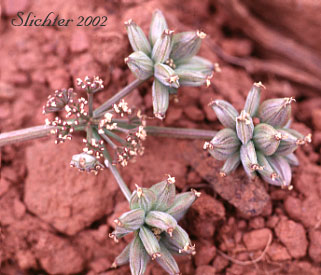 The
photo at right shows the fruits of Watson's desert parsley.
The
photo at right shows the fruits of Watson's desert parsley.
Watson's desert parsley is a puberulent to nearly glabrous perennial, somewhat similar in appearance to Lomatium cous, with one to several stems arising from 5-15 cm from an elongated, stout, to somewhat tuberous rootstock. The stems often lack leaves. The leaves are bipinnate, and including the petioles are 5-8 cm long. The segments of the leaflets are linear in shape with obtuse tips, and range from 2-4 mm long (See photo below.).
Each umbel consists of 4-8 rays of unequal length, the longest measuring from 2-3 cm long (See photo at right.) The involucel consists of a ring of united bracts, the individual bracts somewhat broadly triangular in outline. The flowers are yellowish. The fruits are ovate in shape and 6-7 mm long and up to 4 mm wide with wings less than half as wide as the body of the fruit. The fruits are finely puberulent or occasionally glabrous.Watson's desert parsley may be found in arid, open, often rocky hillsides. It is often found amongst sagebrush.
Watson's desert parsley may be found east of the Cascade Mts. from southern Kittitas, Yakima, and Klickitat counties in Washington to Jefferson county in north-central Oregon.